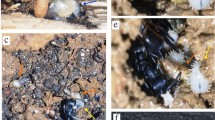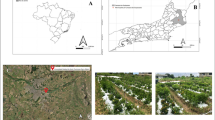Abstract
Animals in Southeast Asia must cope with long periods of fruit scarcity of unpredictable duration between irregular mast fruiting events. Long-term data are necessary to examine the effect of mast fruiting on diet, and particularly on the selection of fallback foods during periods of fruit scarcity. No such data is available for colobine monkeys, which may consume substantial amounts of fruits and seeds when available. We studied the diet of red leaf monkeys (Presbytis rubicunda, Colobinae) in Danum Valley, Sabah, northern Borneo, using 25 mo of behavioral observation, phenology and vegetation surveys, and chemical analysis to compare leaves eaten with nonfood leaves. The monkeys spent 46% of their feeding time on young leaves, 38% on seeds, 12% on whole fruits, 2.0% on flowers, 1.0% on bark, and 1.2% on pith. They spent more time feeding on seeds and whole fruit when fruit availability was high and fed on young leaves of Spatholobus macropterus (liana, Leguminosae) as fallback foods. This species was by far the most important food, constituting 27.9% of the total feeding time, and the feeding time on this species negatively correlated with fruit availability. Consumed leaves contained more protein than nonconsumed leaves, and variation in time spent feeding on different leaves was explained by their abundance. These results suggest that red leaf monkeys show essentially the same response to the supra-annual increase in fruit availability as sympatric monogastric primates, increasing their seed and whole-fruit consumption. However, they depended more on young leaves, in particular Spatholobus macropterus, as fallback foods during fruit-scarce periods than did gibbons or orangutans. Their selection of fallback food appeared to be due to both nutrition and abundance.






Similar content being viewed by others
References
Agetsuma, N. (1995). Foraging strategies of Yakushima macaques (Macaca fuscata yakui). International Journal of Primatology, 16, 595–609.
Ashton, P. S., Givnish, T. J., & Appanah, S. (1988). Staggered flowering in the Dipterocarpaceae: New insights into floral induction and the evolution of mast fruiting in the aseasonal tropics. American Naturalist, 132, 44–66.
Buij, R., Wich, S. A., Lubis, A. H., & Sterck, E. H. M. (2002). Seasonal movements in the Sumatran orangutan (Pongo pygmaeus abelii) and consequences for conservation. Biological Conservation, 107, 83–87.
Burnham, K. P., & Anderson, D. R. (2002). Model selection and multi-model inference (2nd ed.). New York: Springer.
Chapman, C. A., & Chapman, L. J. (2002). Foraging challenges of red colobus monkeys: Influence of nutrients and secondary compounds. Comparative Biochemistry and Physiology. Part A, Molecular & Integrative Physiology, 133, 861–875.
Clutton-Brock, T. H. (1977). Primate ecology: Studies of feeding and ranging behaviour in lemurs, monkeys and apes. Brighton: Academic.
Davies, G. (1991). Seed-eating by red leaf monkeys (Presbytis rubicunda) in dipterocarp forest of northern Borneo. International Journal of Primatology, 12, 119–144.
Davies, A. G., Bennett, E. L., & Waterman, P. G. (1988). Food selection by 2 southeast Asian colobine monkeys (Presbytis rubicunda and Presbytis melalophos) in relation to plant chemistry. Biological Journal of the Linnean Society, 34, 33–56.
Hanya, G., Kiyono, M., Takafumi, H., Tsujino, R., & Agetsuma, N. (2007). Mature leaf selection of Japanese macaques: Effects of availability and chemical content. Journal of Zoology, 273, 140–147.
Harrison, M. J. S. (1985). Time budget of the green monkey, Cercopithecus sabaeus: Some optimal strategies. International Journal of Primatology, 6, 351–376.
Itioka, T., Inoue, T., Kaliang, H., Kato, M., Nagamitsu, T., Momose, K., Sakai, S., Yumoto, T., Mohamad, S. U., Hamid, A. A., & Yamane, S. (2001). Six-year population fluctuation of the giant honey bee Apis dorsata (Hymenoptera: Apidae) in a tropical lowland dipterocarp forest in Sarawak. Annals of the Entomological Society of America, 94, 545–549.
Janson, C., & Chapman, C. (1999). Resources and primate community structure. In J. Fleagle, C. Janson, & K. Reed (Eds.), Primate communities (pp. 237–267). Cambridge, UK: Cambridge University Press.
Kanamori, T., Kuze, N., Bernard, H., Malim, T. P., & Kohshima, S. (2010). Feeding ecology of Bornean orangutans (Pongo pygmaeus morio) in Danum Valley, Sabah, Malaysia: A 3-year record including two mast fruitings. American Journal of Primatology, 72, 820–840.
Kar-Gupta, K., & Kumar, A. (1994). Leaf chemistry and food selection by common langurs (Presbytis entellus) in Rajaji National Park, Uttar Pradesh, India. International Journal of Primatology, 15, 75–93.
Kirkpatrick, R. C. (1999). Colobine diet and social organization. In P. Dolhinow & A. Fuentes (Eds.), The nonhuman primates (pp. 93–105). Mountain View, CA: Mayfield.
Knott, C. D. (1998). Changes in orangutan caloric intake, energy balance, and ketones in response to fluctuating fruit availability. International Journal of Primatology, 19, 1061–1079.
Kool, K. M. (1992). Food selection by the silver leaf monkey, Trachypithecus auratus sondaicus, in relation to plant chemistry. Oecologia, 90, 527–533.
Lambert, J. E. (1998). Primate digestion: Interactions among anatomy, physiology, and feeding ecology. Evolutionary Anthropology, 7, 8–20.
Lambert, J. E. (2007). Seasonality, fallback strategies, and natural selection: A chimpanzee and Cercopithecoid model for interpreting the evolution of the hominin diet. In P. S. Ungar (Ed.), Evolution of the human diet: The known, the unknown, and the unknowable (pp. 324–343). Oxford: Oxford University Press.
Lingenfelder, M. (2005) Rain forest dynamics and response to drought in a Bornean primary lowland dipterocarp forest. Ph.D. thesis, University of Bern, Bern.
Maisels, F., Gauthier-Hion, A., & Gautier, J. P. (1994). Diets of 2 sympatric colobines in Zaire: More evidence on seed-eating in forests on poor soils. International Journal of Primatology, 15, 681–701.
Marshall, A. J., & Wrangham, R. W. (2007). Evolutionary consequences of fallback foods. International Journal of Primatology, 28, 1218–1235.
Marshall, A. J., Boyko, C. M., Feilen, K. L., Boyko, R. H., & Leighton, M. (2009). Defining fallback foods and assessing their importance in primate ecology and evolution. American Journal of Physical Anthropology, 140, 603–614.
Maruhashi, T. (1981). Activity patterns of a troop of Japanese monkeys (Macaca fuscata yakui) on Yakushima Island, Japan. Primates, 22, 1–14.
Mowry, C. B., Decker, B. S., & Shure, D. J. (1996). The role of phytochemistry in dietary choices of Tana River red colobus monkeys (Procolobus badius rufomitratus). International Journal of Primatology, 17, 63–84.
Newbery, D. M., Campbell, E. J. F., Proctor, J., & Still, M. J. (1996). Primary lowland dipterocarp forest at Danum Valley, Sabah, Malaysia. Species composition and patterns in the understorey. Vegetatio, 122, 193–220.
Newbery, D. M., Kennedy, D. N., Petol, G. H., Madani, L., & Ridsdale, C. E. (1999). Primary forest dynamics in lowland dipterocarp forest at Danum Valley, Sabah, Malaysia, and the role of the understorey. Philosophical Transactions of the Royal Society B: Biological Sciences, 354, 1763–1782.
Norhayati, A. (2001) Frugivores and fruit production in primary and logged tropical rainforests. Ph.D. thesis, Faculty of Science and Technology, Universiti Kebangsaan Malaysia, Bangi, Malaysia.
Porter, L. J. (1989). Tannins. In P. M. Dey & J. B. Harborne (Eds.), Methods in plant biochemistry, vol 1. Plant Phenolics (pp. 389–419). London: Academic.
Rautio, P., Bergvall, U. A., Karonen, M., & Salminen, J. P. (2007). Bitter problems in ecological feeding experiments: Commercial tannin preparations and common methods for tannin quantifications. Biochemical Systematics and Ecology, 35, 257–262.
Reed, K. E., & Bidner, L. R. (2004). Primate communities: Past, present, and possible future. Yearbook of Physical Anthropology, 47, 2–39.
Rothman, J. M., Chapman, C. A., & Pell, A. N. (2008). Fiber-bound nitrogen in gorilla diets: Implications for estimating dietary protein intake of primates. American Journal of Primatology, 70, 690–694.
Sakai, S. (2002). General flowering in lowland mixed dipterocarp forests of South-east Asia. Biological Journal of the Linnean Society, 75, 233–247.
Soxhlet, F. (1879). Die gewichtsanalytische Bestimmung des Milchfettes. Polytechnisches J, 232, 461–465.
van Schaik, C. P., & Pfannes, K. (2005). Tropical climates and phenology: A primate perspective. In D. K. Brockman & C. P. van Schaik (Eds.), Seasonality in primates: Studies of living and extinct human and non-human primates (pp. 23–54). Cambridge, UK: Cambridge University Press.
van Soest, P. J., Robertson, J. B., & Lewis, B. A. (1991). Methods for dietary fiber, neutral detergent fiber, and nonstarch polysaccharides in relation to animal nutrition. Journal of Dairy Science, 74, 3583–3597.
Vogel, E. R., Haag, L., Mitra-Setia, T., van Schaik, C. P., & Dominy, N. J. (2009). Foraging and ranging behavior during a fallback episode: Hylobates albibarbis and Pongo pygmaeus wurmbii compared. American Journal of Physical Anthropology, 140, 716–726.
Wich, S. A., & van Schaik, C. P. (2000). The impact of El Niño on mast fruiting in Sumatra and elsewhere in Malesia. Journal of Tropical Ecology, 16, 563–577.
Wich, S. A., Utami-Atmoko, S. S., Setia, T. M., Djoyosudharmo, S., & Geurts, M. L. (2006). Dietary and energetic responses of Pongo abelii to fruit availability fluctuations. International Journal of Primatology, 27, 1535–1550.
Wong, S. T., Servheen, C., Ambu, L., & Norhayati, A. (2005). Impacts of fruit production cycles on Malayan sun bears and bearded pigs in lowland tropical forest of Sabah, Malaysian Borneo. Journal of Tropical Ecology, 21, 627–639.
Yasuda, M., Matsumoto, J., Osada, N., Ichikawa, S., Kachi, N., Tani, M., Okuda, T., Furukawa, A., Nik, A. R., & Manokaran, N. (1999). The mechanism of general flowering in Dipterocarpaceae in the Malay Peninsula. Journal of Tropical Ecology, 15, 437–449.
Yeager, C. P., Silver, S. C., & Dierenfeld, E. S. (1997). Mineral and phytochemical influences on foliage selection by the proboscis monkey (Nasalis larvatus). American Journal of Primatology, 41, 117–128.
Zhou, Q. H., Huang, Z. H., Wei, X. S., Wei, F. W., & Huang, C. M. (2009). Factors influencing interannual and intersite variability in the diet of Trachypithecus francoisi. International Journal of Primatology, 30, 583–599.
Acknowledgments
This study would not have been possible without the hard work of our field assistants, Syamsudin Jail, Sharry bin Mustah, Saharudin Idos, Unding Jami, Sallehudin Jail, and Rayner Jupili. We thank the staff of the Danum Valley Field Centre and our colleagues there for their hospitality and help, in particular Jimmy Omar, Mike Bernadus, Glen Reynolds, Tomoko Kanamori, Noko Kuze, and Siew Te Wong. Constructive comments by Drs. Joanna Setchell, Oliver Shülke, and an anonymous reviewer greatly improved the manuscript. The Economy Planning Unit of Malaysia and the State of Sabah and the Danum Valley Management Committee of Yayasan Sabah permitted our study. This study was financed by the JSPS Core-to-Core Program (HOPE), the MEXT Grant-in-Aid for JSPS Overseas Fellows, Grant-in-Aid for Young Scientists (No. 20770195 and No. 22687002) to G. Hanya, Primate Society of Japan, the 21st Century COE Program (A14), and the Global COE Program “Formation of a Strategic Base for Biodiversity and Evolutionary Research: From Genome to Ecosystem”.
Author information
Authors and Affiliations
Corresponding author
Additional information
An erratum to this article is available at http://dx.doi.org/10.1007/s10764-014-9785-1.
Rights and permissions
About this article
Cite this article
Hanya, G., Bernard, H. Fallback Foods of Red Leaf Monkeys (Presbytis rubicunda) in Danum Valley, Borneo. Int J Primatol 33, 322–337 (2012). https://doi.org/10.1007/s10764-012-9580-9
Received:
Accepted:
Published:
Issue Date:
DOI: https://doi.org/10.1007/s10764-012-9580-9




